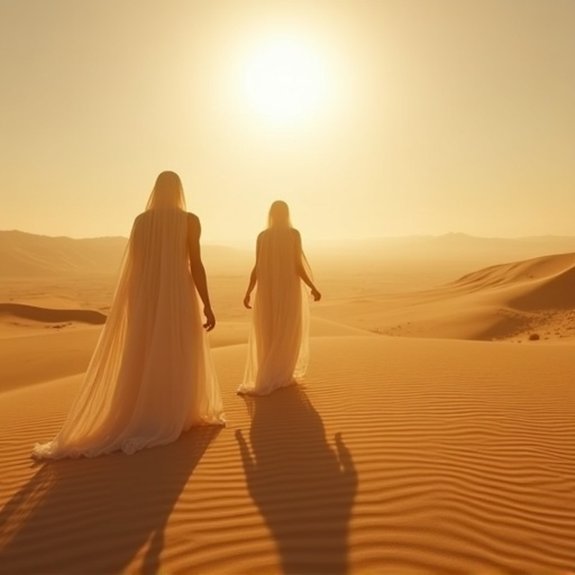Ghosts in the Desert: Mirages or Spirits?
The Sahara’s endless dunes hold secrets that’ve puzzled travelers for millennia. Desert wanderers report shadowy figures that vanish when approached, mysterious lights dancing across barren landscapes, and footsteps where no one’s walked. Scientists point to heat mirages and dehydration-induced hallucinations, yet these explanations don’t satisfy everyone. What’s truly happening when isolation meets extreme conditions in Earth’s most desolate places? The answer might challenge everything modern society believes about reality.
Introduction

When the sun sets behind the jagged peaks of the Mojave, something stirs in the abandoned mining towns that dot the landscape. Locals won’t venture near these ghost towns after dark, and they’ve got stories that’ll make anyone think twice. For over a century, travelers have reported strange lights, unexplained voices, and shadowy figures moving through crumbling buildings.
Scientists explain these phenomena as mirages caused by temperature inversions and light refraction in the desert’s extreme conditions. The heat creates optical illusions that trick the brain into seeing things that aren’t there. Yet witnesses swear they’ve encountered something more than atmospheric anomalies. They describe cold spots in hundred-degree heat, footsteps in empty buildings, and whispers carried on windless nights. Whether these experiences stem from natural phenomena or supernatural presence remains the desert’s most intriguing mystery.
Ancient Egyptian Desert Spirit Beliefs
Though modern ghost towns capture today’s imagination, ancient Egyptians developed complex beliefs about desert spirits thousands of years ago. They believed the vast wastelands beyond the Nile’s fertile banks harbored supernatural entities that threatened travelers. Seth, the god of chaos and storms, ruled these barren regions where malevolent spirits dwelled.
Egyptian texts describe the “akhu” – transfigured spirits who’d wander the desert if proper burial rites weren’t performed. Desert demons called “sebau” attacked those who ventured too far from civilization. The Egyptians also feared the “mutu” – dangerous dead who hadn’t successfully transitioned to the afterlife.
These beliefs weren’t merely superstition. They served practical purposes, warning people about real desert dangers while reinforcing social cohesion. The spirits represented nature’s hostility and reminded Egyptians why they’d clustered along the life-giving Nile.
Notable Cases or Sightings

How does a ghost town earn its haunted reputation? Bodie, California‘s abandoned mining settlement, attracts paranormal investigators who’ve documented unexplained footsteps in the Methodist church and children’s laughter near the schoolhouse. The town’s curse supposedly strikes anyone who removes artifacts from the site.
Arizona’s Superstition Mountains harbor the Lost Dutchman’s ghost, who reportedly guards his hidden gold mine. Hikers’ve photographed mysterious lights and shadow figures near Weaver’s Needle, while others claim they’ve heard pickaxes striking rock at night.
Death Valley’s Racetrack Playa puzzled observers until scientists explained its moving rocks in 2014, but witnesses still report phantom stagecoaches crossing the valley floor. Rangers’ve collected accounts of spectral miners near abandoned camps, particularly around Rhyolite’s ruins where visitors describe seeing translucent figures entering collapsed mine shafts.
Common Theories or Explanations
Scientists and skeptics offer several explanations for these desert phenomena. They’ve identified heat mirages as the primary culprit, where temperature gradients bend light rays, creating illusory images. Desert conditions amplify this effect, making distant objects appear to float or shimmer unnaturally.
Psychologists point to pareidolia—the brain’s tendency to recognize patterns where none exist. In isolation, exhaustion, and extreme temperatures, people’s minds fill gaps with familiar forms. Dehydration and heat stroke also trigger hallucinations that witnesses later interpret as paranormal encounters.
Some researchers cite electromagnetic fields from underground mineral deposits that might affect brain activity. Others note that many sightings occur near old mining sites where toxic gases could cause disorientation. Cultural expectations play a role too; people who’ve heard ghost stories are more likely to interpret ambiguous experiences as supernatural.
Frequently Asked Questions
What Safety Precautions Should I Take When Investigating Desert Ghost Sightings?
Investigators should bring extra water, GPS devices, and sun protection. They’ll need to inform others of their location, avoid traveling alone, and carry emergency supplies. Desert conditions can quickly become dangerous without proper preparation.
Are Certain Times of Day Better for Witnessing Desert Spirit Phenomena?
Desert paranormal investigators claim dawn and dusk offer prime viewing conditions when temperature fluctuations create atmospheric distortions. They’ve documented most sightings during these changeover hours when shadows lengthen and light plays tricks on perception.
What Equipment Do Paranormal Investigators Use to Detect Desert Spirits?
Paranormal investigators use EMF detectors, thermal cameras, and digital voice recorders in desert environments. They’ll often bring infrared thermometers to measure temperature anomalies and full-spectrum cameras that capture light beyond human vision’s normal range.
Can Desert Spirits or Mirages Be Photographed or Recorded on Video?
Photographers can capture mirages on video and in photos since they’re optical phenomena caused by light refraction. Desert spirits, however, can’t be reliably photographed as there’s no scientific evidence they exist beyond anecdotal claims.
Are There Guided Tours Available for Desert Ghost Hunting Experiences?
Yes, several tour companies offer desert ghost hunting experiences. They’ll take visitors to reportedly haunted locations like abandoned mining towns and Native American sites. These guided expeditions typically include equipment rentals and storytelling sessions.


